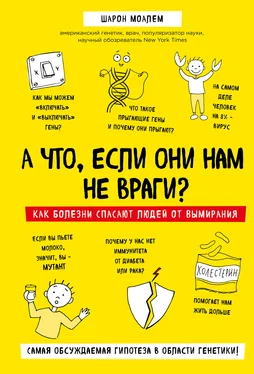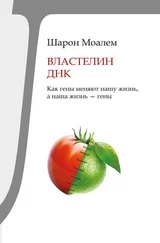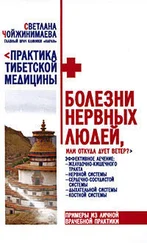Seema Singh Bangalore, “ ‘Wrong’ Genes May Raise AIDS Risk for Millions,” New Scientist, 16 апреля 2005;
Julie Clayton, “Beating the Odds,” New Scientist, 8 февраля 2003;
J. Novembre, A. P. Galvani, and M. Slatkin. 2005. The geographic spread of the CCR5-Delta32 HIV-resistance allele. PLoS Biol 3(11):e339.
Глава 4: От боба добра не ищут
58. См. стр. 40-41 в:
M. Toussaint-Samat, A History of Food (Cambridge, MA: Blackwell Reference, 1993);
D. Zohary and M. Hopf, Domestication of Plants in the Old World: The Origin and Spread of Cultivated Plants in West Asia, Europe, and the Nile Valley (New York: Oxford University Press, 2000);
J. Golenser, J. Miller, D. T. Spira, et al. 1983. Inhibitory effect of a fava bean component on the in vitro development of Plasmodium falciparum in normal and glucose-6-phosphate dehydrogenase deficient erythrocytes. Blood 61(3):507–510.
59. J. Meletis and K. Konstantopoulos. 2004. Favism – from the “avoid fava beans” of Pythagoras to the present. Haema 7(1):17–21.
60. Цитата приведена в:
R. Parsons, “The Long History of the Mysterious Fava Bean,” Los Angeles Times, 29 мая 1996.
61. K. Iwai, A. Hirono, H. Matsuoka, et al. 2001. Distribution of glucose 6-phosphate dehydrogenase mutations in Southeast Asia. Hum Genet 108(6):445–449;
A. K. Roychoudhury and M. Nei. Human Polymorphic Genes: World Distribution (New York: Oxford University Press, 1988);
S. H. Katz and J. Schall. 1979. Fava bean consumption and biocultural evolution. Med Anthro 3:459–476;
S. A. Tishkoff, R. Varkonyi, N. Cahinhinan, et al. 2001. Haplotype diversity and linkage disequilibrium at human G6PD: recent origin of alleles that confer malarial resistance. Science 293(5529):455–462.
62. Подробнее на эту тему читайте стр. 70–91 в:
G. P. Nabhan, Why Some Like It Hot: Food, Genes, and Cultural Diversity (Washington, DC: Island Press/Shearwater Books, 2004);
C. F. Ockenhouse, A. Magill, D. Smith andW. Milhous. 2005. History of U.S. military contributions to the study of malaria. Mil Med 170(4 Suppl):12–16;
A. S. Alving, P. E. Carson, C. L. Flanagan, and C. E. Ickes. 1956. Enzymatic deficiency in primaquine- sensitive erythrocytes. Science 124(3220):484–485.
63. См. cтр. 92–94 в:
E. Barnes, Diseases and Human Evolution (Albuquerque: University of New Mexico Press, 2005);
H. Ginsburg, H. Atamna, G. Shalmiev, et al. 1996. Resistance of glucose-6-phosphate dehydrogenase deficiency to malaria: effects of fava bean hydroxypyrimidine glucosides on Plasmodium falciparum growth in culture and on the phagocytosis of infected cells. Parasitology 113(Pt 1):7–18.
64. Что касается количества половых хромосом, то возможны и другие комбинации, в том числе синдром Тернера, который приводит к наличию только одной полностью функциональной X-хромосомы (X,O), и синдром Клайнфельтера, при котором у мужчины имеется дополнительная X-хромосома (XXY).
65. Про оригинальные исследования читайте:
A. Fugh-BermanandF. Kronenberg. 2001. Red clover (Trifolium pratense) for menopausal women: current state of knowledge. Menopause 8(5):333–337;
H. W. Bennetts, E. J. Underwood, and F. L. Shier. 1946. A specific breeding problem of sheep on subterranean clover pastures in Western Australia. Aust J Agric Res 22:131–138;
S. M. Heinonen, K. Wahala, and H. Adlercreutz. 2004. Identification of urinary metabolites of the red clover isoflavones formononetin and biochanin A in human subjects. J Agric Food Chem 52(22):6802–6809;
M. A. Wallig, K. M. Heinz-Taheny, D. L. Epps, and T. Gossman. 2005. Synergy among phytochemicals within crucifers: does it translate into chemoprotection? JNutr 135(12 Suppl): 2972S–2977S.
Дополнительную информацию про «натуральные» токсины в продуктах питания читайте в:
K. F. Lampe, M. A. McCann, and American Medical Association, AMA Handbook of Poisonous and Injurious Plants (Chicago: American Medical Association, distributed by Chicago Review Press, 1985);
M. Stacewicz-Sapuntzakis and P. E. Bowen. 2005. Role of lycopene and tomato products in prostate health.Biochim Biophys Acta 1740(2):202–205;
National Research Council (U.S.), Food Protection Committee, Toxicants OccurringNaturally in Food (Washington, DC: National Academy of Sciences, 1973);
D. R. Jacobs Jr. and L. M. Steffen. 2003. Nutrients, foods, and dietary patterns as exposures in research: a framework for food synergy. Am J Clin Nutr 78(3 Suppl):508S–513S;
J. M. Kingsbury, Poisonous Plants of the United States and Canada (Englewood Cliffs, NJ: Prentice-Hall, 1964).
Про токсины в маниоке читайте:
M. Ernesto, A. P. Cardoso, D. Nicala, et al. 2002. Persistent konzo and cyanogen toxicity from cassava in northern Mozambique. Acta Trop 82(3):357–362;
M. L. Mlingi, M. Bokanga, F. P. Kavishe, et al. 1996. Milling reduces the goitrogenic potential of cassava. IntJFoodSciNutr 47(6):445–454.
Про токсины в нуте читайте:
P. Smirnoff, S. Khalef, Y. Birk, and S. W. Applebaum. 1976. A trypsin and chymotrypsin inhibitor fromchickpeas (Cicer arietinum). BiochemJ 157(3):745–751.
66. Историю создания противозачаточной таблетки “Pill” читайте в:
C. Djerassi, This Man’s Pill: Reflections on the 50th Birthday of the Pill (New York: Oxford University Press,2001)и
C. Djerassi, The Pill, Pygmy Chimps, and Degas’ Horse: The Autobiography of Carl Djerassi (New York: Basic Books, 1992).
67. Leigh Dayton, “Australia Exports Poisonous ‘Lentils,’ ” New Scientist, 3 октября 1992;
Для более подробной информации пройдите по ссылке:
www.cropscience.org.au/icsc2004/poster/3/2/1/769_vetch.htm.
68. J. L. Muller. 1998. Love potions and the ointment of witches: historical aspects of the nightshade alkaloids. JToxicolClinToxicol 36(6):617–627.
69. R. Beverley and L. B. Wright, The History and Present State of Virginia (Charlottesville, VA: Dominion Books, 1968);
S. Berkov, R. Zayed, and T. Doncheva. 2006. Alkaloid patterns in some varieties of Datura stramonium. Fitoterapia 77(3):179–182.
70. Наблюдаются значительные вариации ферментов класса P450 среди различных этнических групп – скорее всего, это является следствием того, что они жили в очень разной «химической среде». Именно эта цитохромная система используется организмом для усвоения или «детоксикации» различных химических веществ, в том числе медицинских препаратов. В следующей статье подробно рассматривается метаболизм капсаицина – вещества, которое добавляет острым перцам жгучести за счет цитохрома P450:
C. A. Reilly, W. J. Ehlhardt, D. A. Jackson, et al. 2003. Metabolism of capsaicin by cytochrome P450 produces novel dehydrogenated metabolites and decreases cytotoxicity to lung and liver cells. ChemResToxicol 16(3):336–349.
Эти различия также лежат в основе предполагаемого будущего персонализированной медицины, в которой большое внимание уделяется генам – ее можно назвать фармакогенетикой или фармакогеномикой. Читайте:
Читать дальше
Конец ознакомительного отрывка
Купить книгу











